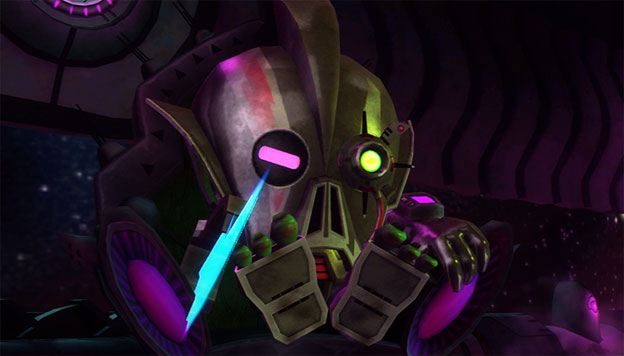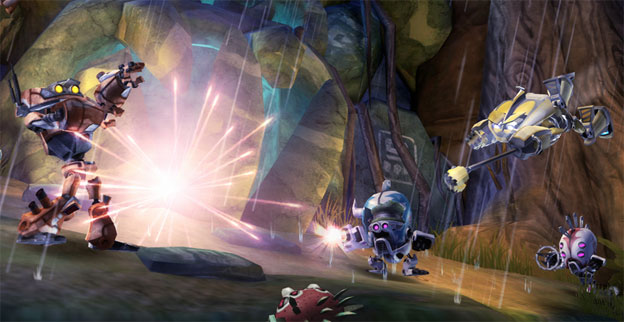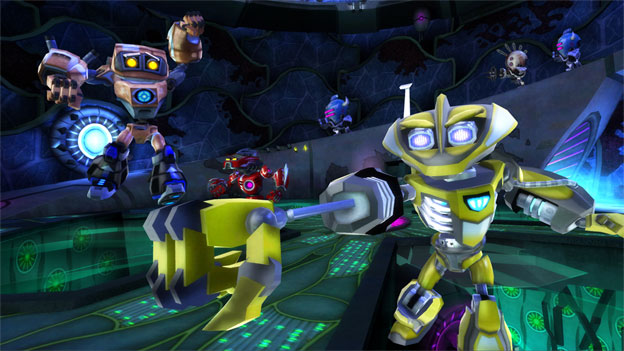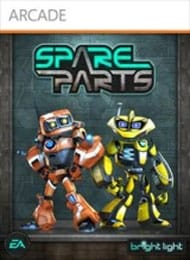Crash Landing
Games for kids in contemporary design don’t seem to get much attention from the industry, and, outside of Nintendo, titles that kids can enjoy as much as adults are pretty few and far between. EA has its fair share of mostly forgettable games for younger gamers, but with the likes of Hasbro Game Night and My Sims in their ranks, these generally aren’t anything to write home about. Spare Parts, a game made and subsequently released with very little fanfare, seemed different. It still has a kiddy tone and aesthetic, but the gameplay looked similar to something like Ratchet & Clank or Jak & Daxter—in other words, something with enough depth for older gamers to enjoy as well—and any game that Simon Pegg chooses to lend his voice to couldn’t be all that bad, right?
That being said, I really wish Spare Parts had been given the luxury of either a little more playtesting or just another month or two in development. For the most part, it’s a decent game, with good production values for a digital download game and solid game mechanics. The problem here is that much of the design is so maddeningly obtuse or clearly not quite finished, you’ll want to wring your cute little robot’s neck.

The game starts out fine enough. A spaceship crash lands on an alien planet and as a silent robot, MAR-T (who seems like he may be gunning for the WALL-E approach), it’s your job to explore the untamed lands to collect – you guessed it – spare parts to repair your ship. Con-rad, the ship’s AI played by Simon Pegg, is your guide, although you’d think for as many times as you’ll be lost as to what to do, it would give you more nudges in the right direction. (Pegg still does a good job, however.) The game looks lush, again reminding one of Naughty Dog’s early cartoony work, and traversal through the jungle canopy, caves, and other environments is generally a visual treat with (for the most part) solid animation. Though it’s light on narrative, I couldn’t help but want to like Spare Parts’ world and characters, charming as they are. Sadly, gameplay doesn’t quite have the same charm.
Right off the bat, it’s clear that this bun needed a little more time in the oven, because the slight delay on the controls makes MAR-T feel stiff and sluggish. Obviously, that’s not a great place to be with a game that’s focused on combat and (especially) platforming, though you get used to it after a few levels. Combat feels somewhat similar: though MAR-T has a few different moves (punches, kicks, special moves with double jumps, etc.), the reaction time has a small delay when you’re hitting something, so during, say, the final punch to the body of a mucous worm, the thing won’t actually explode until about half a second after the hit connects. It’s nothing major, but it does pull you out of the game and make for less satisfying combat than Spare Parts could have had.

However, problems with unresponsive controls and somewhat lacking combat are middling compared to Spare Parts’ real issue: the design itself. As you go through each bite-sized level collecting parts for your ship, you get various upgrades for MAR-T, such as rocket boots, a strong arm to break or push objects, an EMP device, or a special glove to interact with alien machinery. These additions to your abilities naturally should help break up the gameplay, varying the tasks you have to complete (and how you have to complete them) by switching back and forth between your selection of tool as needed. And while that’s all well and good in theory, in practice, this is where Spare Parts has a few missing screws.
The most useful of MAR-T’s various abilities are special goggles that, when activated, will reveal what objects in the environment you can interact with, and, more importantly, which ability is needed in order to do. Theoretically, this should be all you need in order to progress, but usually it’s not. Anyone playing Spare Parts will be glad to have said goggles, but more often than not you’ll still be stuck wondering exactly how you’re supposed to use whatever tool the game is referring you to, or (even more likely) what effect the item’s interaction actually has on your environments. Perhaps this is more of a sad commentary on just how much hand-holding—whether through camera cues or more direct methods of directional steering—we actually need in games today, but you’ll likely lose count of the number of times you’re told to, say, push a block somewhere or activate a switch with your EMP, only for your actions to have what appears to be little to no effect. Sometimes this is a matter of taking certain other steps first (the game often puts you in puzzle-type situations with various constituent parts without even an inkling of any kind of order of operation), sometimes it’s an unknown order to something like pressing a series of buttons in order to activate a mechanism. There’s also times when you have to negotiate a puzzle that’s clearly designed for co-op. (Though Spare Parts is more or less billed as a co-op adventure, an AI partner is oddly absent when playing it solo.) And then there are times it doesn’t even matter at all: since every level has a number of additional parts to collect once you’ve gained some new abilities, you may find yourself spending time trying to solve a puzzle or reach an area that is impossible to access the first time you come across it.—the game doesn’t make any differentiation between what’s unnecessary and required.

However, even when you’re barking up the right tree, the interaction points are usually so finicky it can be hard to even find them. This can be particularly maddening when your goggles are telling you that what you want to interact with you is right in front of you. As an example, take the boss of the second world, a giant hybrid spider-monkey. The creature’s legs are spread out across the corners of a massive cave, and there’s a stone dais with arrow-like paths leading up to it underneath the beasts’ middle. I won’t get into how you beat the level (which is inexplicable, as it ran contrary to the damage you actually do to the boss), because the process is far too complicated and irritating to explain with any brevity. However, even the actions needed leading up to that point are also complicated.

The game gives you a cue that you have to stomp on a stone hand in the back of the dais, though it doesn’t explain that doing so knocks a stone forward in the front, which you then need to push back in. Pushing the stone back releases one of the eggs that lay on top of the dais, which for some reason have spikes on them. Now, at this point, it’s natural from a design perspective to think you’ll need to do something with the eggs. It turns out you have to push them down the outward paths to the edge of the spider-monkey’s hands. Finally, you have to knock the creature’s hand into the egg so that it crushes it and weakens the cave’s foundations.
That may sound easy on paper with all the steps laid out, but it took a great deal more trial and error than was necessary in order to figure it out, particularly the interactions with the eggs. The goggles were instructing me to use the strong arm on the eggs, but first I couldn’t find the exact interaction point needed in order to do anything. Then I didn’t know whether I needed to hit the spider-monkey’s hand or try to drag it, and again had to try every option possible from almost every conceivable angle. Ultimately what was probably meant to be a ten-minute level turned into a 45-minute ordeal, and much of the rest of Spare Parts’ design is similar.
I hate harping on design for a game that could have been good, but if these problems had been dealt with, Spare Parts could have had the potential to be something special. But without some kind of patch or just a better-made sequel (or both), this is hard sell. Only the most patient fans of robot-related platforming need apply, and even then I would still exercise caution.
RATING OUT OF 5 RATING DESCRIPTION 3.8 Graphics
Graphics aren’t anything to write home, though the world is lush and animations and character models are pretty smooth and detailed. 2.2 Control
Sluggish controls do not mix well with platforming. This needed more play-testing. 4.0 Music / Sound FX / Voice Acting
The lively music is surprisingly catchy, and Simon Pegg does a good job as the game’s sole voice actor. Sound is otherwise mostly forgettable. 2.0 Play Value
Maddeningly obtuse design more often than not makes Spare Parts an exercise in irritation rather than fun. 2.3 Overall Rating – Poor
Not an average. See Rating legend below for a final score breakdown.
| Review Rating Legend | |||
|---|---|---|---|
| 0.1 – 1.9 = Avoid | 2.5 – 2.9 = Average | 3.5 – 3.9 = Good | 4.5 – 4.9 = Must Buy |
| 2.0 – 2.4 = Poor | 3.0 – 3.4 = Fair | 4.0 – 4.4 = Great | 5.0 = The Best |
Game Features:
